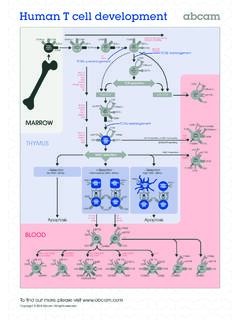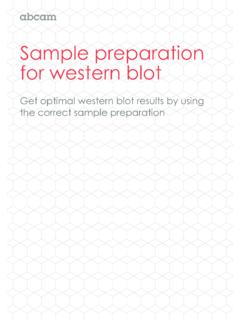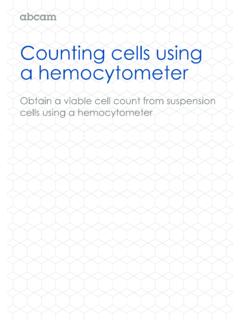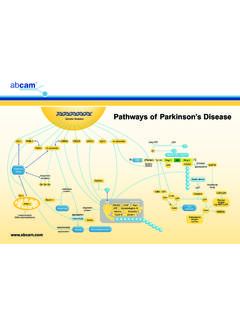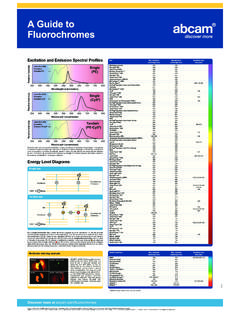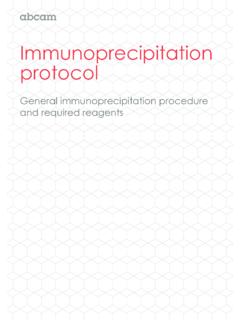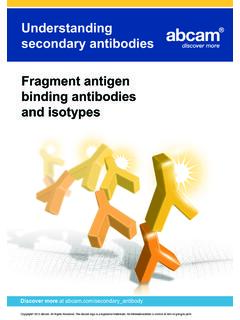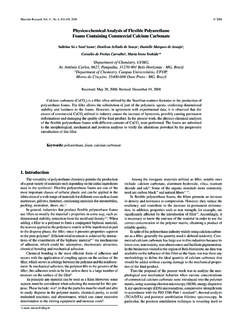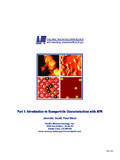Transcription of Apoptosis - Abcam
1 ApoptosisTools for cell death series 13 ContentsCell death ..4 Apoptosis ..5 Mechanisms of Apoptosis ..5 Hallmarks of Apoptosis ..7 Detecting Apoptosis .. 8 Activation of pro-apoptotic members of the Bcl-2 family ..8 Loss of membrane asymmetry ..9 Caspases ..11 Antibody-based methods ..12 Substrate-based methods ..13 Calpain and cathepsins ..14 Mitochondrial transmembrane potential ..15 Cytochrome c release ..17 Chromatin condensation ..19 Genomic DNA fragmentation ..19 Increase of sub G1 population ..21 Cell membrane blebbing ..22 Tips for Apoptosis assays ..23 Use of Apoptosis inducers and inhibitors ..23 Analyze single cells ..23 Be aware of cell line variation ..24 General considerations ..25 References ..274 Cell deathCell death happens when a cell fails to maintain essential life functions and can be non-programmed, in the case of injury or trauma, or programmed, as in processes like Apoptosis and autophagy.
2 Cell death can be classified according to its morphological appearance (such as apoptotic or necrotic), enzymological criteria (with or without the involvement of distinct proteases), functional aspects (programmed or non-programmed), or immunological characteristics (immunogenic or non-immunogenic)1 .Before studying cell death mechanisms, researchers should ensure cell death has happened . The Nomenclature Committee on Cell Death (NCCD) has proposed that researchers should define a cell as dead when the following features are observed1:1 . The cell has lost the plasma membrane integrity2 . The cell has undergone complete disintegration3 . Whatever is left of the cell has been phagocytosed by the neighboring cells in vivoIn this guide, we aim to provide you with an overview of Apoptosis , the most studied and well-known type of cell death, the most common parameters used to assess Apoptosis , and tools you can use to study cell death in your research.
3 5 ApoptosisApoptosis is a type of programmed cell death that is critical for numerous normal physiological processes . Historically, Apoptosis has been defined by its morphological features, most of which were described in the 1970s by John Kerr2 . Apoptotic morphology includes cell shrinkage, membrane blebbing, chromosome condensation (pyknosis) and nuclear fragmentation (karyorrhexis), DNA laddering, and the eventual engulfment of the cell by phagosomes . In contrast to necrosis, the apoptotic cell does not provoke an inflammatory response and only individual cells are affected by Apoptosis in vivo .Mechanisms of apoptosisApoptosis is characterized by the activation of a family of cysteine-aspartate proteases known as caspases, involved in the restricted proteolysis of over 400 proteins . The two main pathways through which Apoptosis is initiated are the intrinsic and extrinsic cell death pathways, both of these resulting in caspase activation.
4 The intrinsic cell death pathway is governed by the Bcl-2 family of proteins, which regulate commitment to cell death through mitochondrial permeabilization . Many intracellular death signals are communicated through the intrinsic cell death pathway, such as DNA damage, oncogene activation, growth factor deprivation, ER stress, and microtubule disruption . The key step in the intrinsic cell death pathway is permeabilization of the mitochondrial outer membrane, which has been identified as a point of no return after which cells are committed to cell death .Following permeabilization, the release of various proteins from the mitochondrial intermembrane space promotes caspase activation and Apoptosis . Cytochrome c binds to Apoptosis protease-activating factor-1 (APAF1), inducing its oligomerization and thereby forming a structure called the apoptosome that recruits and activates an initiator caspase, caspase-9.
5 Caspase-9 cleaves and activates the executioner caspases, caspase-3 and -7, leading to Apoptosis .Activation of the extrinsic cell death pathway occurs following the binding on the cell surface of death receptors to their corresponding ligands such as Fas, TNFR1, or TRAIL . These death receptors have two distinct signaling motifs: death domains (DD) and death effector domains (DED) that allow them to interact and recruit other adaptor molecules, such as FAS-associated death domain protein (FADD) and caspase-8, which can then directly cleave and activate caspase-3 and caspase-7, leading to apoptosis3 .6 TNF, FasL, TRAILPumaBadBimBidDrugs SteroidGrowth factorwithdrawalUVTaxolFADDTRADDFADDTRAD DcLAPTRAF2 RIP1 CYLDTAK1 IKKaIKK IKK NIKNFkBlkBaNFkBlkBaNFkBCaspase 8 NoxatBIDBidMitochondriaBcl-2 Bcl-XLMcl-1 Bax/BakSmac/DIABLOXIAPBax/BakNoxaPumaMcl -1 Bax/BakBax/BakArtsFLIPRIP1 TRAF2 Bax/BakCaspase 3/6/7 CADICADROCKCasp 7 Cell shrinkage Membrane blebbingDNA fragmentationPARPLAMINFLIPXIAPER stressCyto cCaspase 9 Caspase 9 Caspase 12 Apaf-1[Ca2+]Endo GCalpainAIFE xtrinsic pathwayIntrinsicpathwayHypoxiaFigure 1.
6 Apoptosis pathway overview. Apoptosis is induced via two main routes involving either the mitochondria (intrinsic pathway) or the activation of death receptors (extrinsic pathway), converging on caspase activation. ANT: adenine nucleotide translocator; CypD: cyclophilin D; MDM: multi-domain members; VDAC: voltage-dependent anion channel. Download your Apoptosis pathway card7 TNF, FasL, TRAILPumaBadBimBidDrugs SteroidGrowth factorwithdrawalUVTaxolFADDTRADDFADDTRAD DcLAPTRAF2 RIP1 CYLDTAK1 IKKaIKK IKK NIKNFkBlkBaNFkBlkBaNFkBCaspase 8 NoxatBIDBidMitochondriaBcl-2 Bcl-XLMcl-1 Bax/BakSmac/DIABLOXIAPBax/BakNoxaPumaMcl -1 Bax/BakBax/BakArtsFLIPRIP1 TRAF2 Bax/BakCaspase 3/6/7 CADICADROCKCasp 7 Cell shrinkage Membrane blebbingDNA fragmentationPARPLAMINFLIPXIAPER stressCyto cCaspase 9 Caspase 9 Caspase 12 Apaf-1[Ca2+]Endo GCalpainAIFE xtrinsic pathwayIntrinsicpathwayHypoxiaHallmarks of apoptosisApoptosis occurs via a complex signaling cascade that is tightly regulated at multiple points, providing many opportunities to evaluate the proteins involved (figure 2).
7 LivePoint of no returnRelative timeParameters of apoptosis1. Loss of membrane asymmetry2. Activation of pro-apoptotic Bcl-2 proteins3. Caspase activation4. i M and cytochrome c release5. hSub G1 population6. Nuclear condensation7. DNA fragmentation8. Cell membrane blebbingDeadFigure 2. Hallmarks of Apoptosis . These events do not happen in a sequential order, and many of them will overlap and occur at the same time. Loss of membrane asymmetry or initiation of caspase cascade are biochemical features of Apoptosis which do not necessarily lead to cell death. However, other downstream features such as decrease of the mitochondrial membrane potential ( m) and concomitant release of cytochrome c into the cytosol, are generally considered points of no return, after which it is very unlikely the cell will the following chapters, we will describe the different tools that you can use to detect Apoptosis in your particular samples and to help you identifying the most appropriate method for your experimental settings.
8 8 Detecting apoptosisActivation of pro-apoptotic members of the Bcl-2 familyThe Bcl-2 family consists of a number of evolutionarily conserved proteins that share one or more of theBcl-2 homology (BH) domains . The members of the Bcl-2 family can either promote or inhibit Apoptosis , depending on the BH domains they contain . The anti-apoptotic members, such as Bcl-2 and Bcl-X(L), conserve all four BH domains; the pro-apoptotic members, such as Bax, Bak or Bad, always contain the BH3 domain and may have lost other domains .There is a dynamic balance between anti-apoptotic and the pro-apoptotic proteins . When the intrinsic pathway is activated, some of the pro-apoptotic members will dimerize and form pores on the outer mitochondrial membrane, leading to the release of APAF1 and other mitochondrial proteins for subsequent activation of downstream proteins like caspases4 .One of the simplest methods to look at activation of pro-apoptotic Bcl-2 proteins is by looking at the change in protein levels by western blot using a specific antibody.
9 For example, figure 3 shows how expression levels of Bax change in spleen and liver from mouse after aspirin treatment .Figure 3. Levels of pro-apoptotic Bax were monitored in rat liver and spleen homogenates treated with aspirin (ASA) and with or without phyllanthus niruri protein (PNP), a novel antioxidant protein. Bax was detected using anti-Bax antibody [E63] (ab32503). Image adapted from Bhattacharyya S. et al , protein expression levels might not always change in a particular cell type or injury . In these instances, there are several other techniques that can be used to detect the activation of Bcl-2 pro-apoptotic members: Assess the oligomerization with other pro-apoptotic proteinsThis can be done by immunoprecipitating one of the proteins and detecting its oligomerization partner by western blot Assess the mitochondrial localization of the activated proteinsThis can be done by performing western blot on cell fractions, or by looking at localization of the activated proteins in the mitochondria together with mitochondrial dyes by immunofluorescence9 Product highlight Anti-Bcl-2 antibody [E17]Detection of Bcl-2 expression in human cell lysates (20 g/lane) with anti-Bcl-2 antibody [E17] (1:10,000 dilution).
10 Lane 1: Jurkat, lane 2: HeLa, lane 3: SH-SYSY5 . Anti-Bcl-2 antibody [E17] (ab32124) has been extensively validated for WB, IP and IHC .Loss of membrane asymmetryThe loss of cellular membrane asymmetry is an early sign of Apoptosis , wherein embedded phosphatidylserine (PS) residues in the inner plasma membrane become externalized and signal phagocytosis .Annexin V, a human placental protein that specifically binds to PS in the presence of calcium and fluorochrome-conjugated annexin V in particular, is a commonly used tool to detect and quantify the PS exposure characteristic of membrane asymmetry6 .The binding of fluorochrome-conjugated annexin V to exposed PS can be detected by flow cytometry or fluorescence microscopy (figure 4) . While fluorescence microscopy will allow the visualization of the event, flow cytometry is the most useful method as it allows for a quick and accurate quantification of cells with exposed PS.



